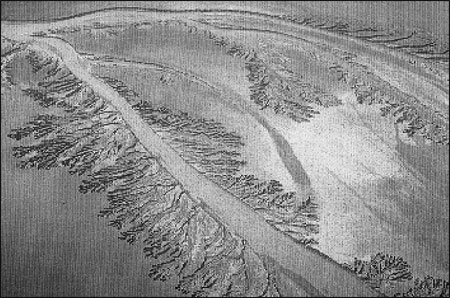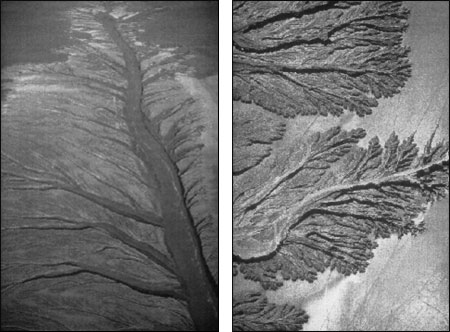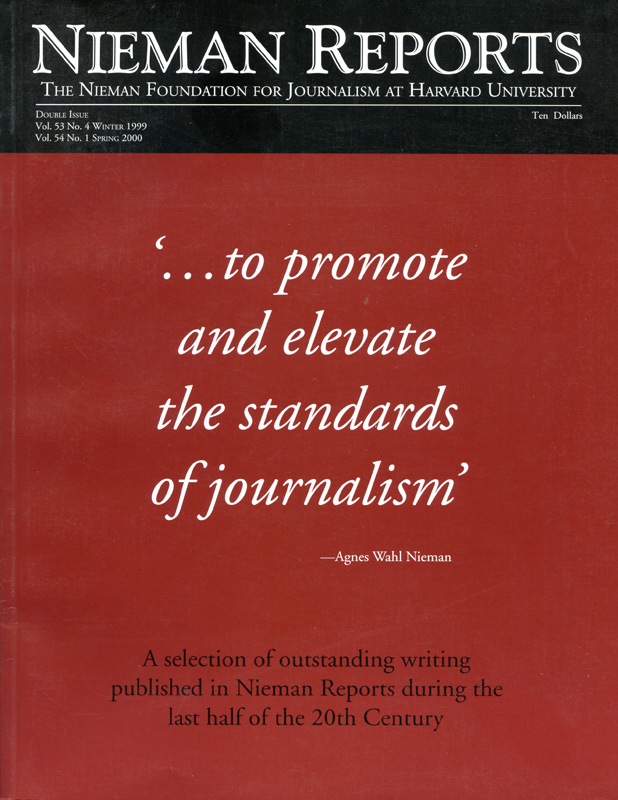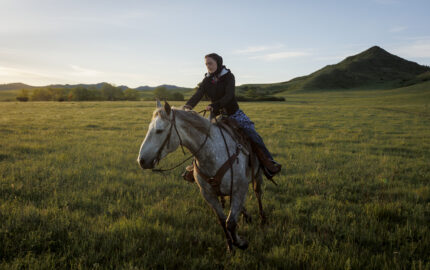[This article originally appeared in the Autumn 1974 issue of Nieman Reports.]
The media—and in particular newspapers—are taken to task by Edwin Newman in the October [1974] issue of The Atlantic for appropriating words and phrases, overusing, abusing and, finally, sucking them dry. With this premise in mind, let’s proceed to the word “photography.” Its derivation and direct translation read: “to write with light.” Let’s look at the light writings that appear in our daily newspapers. Same, same. Thus, it is not only words that grow stale, and even though photography has made great advances in the last 20 years, very little progress is manifested in our daily pictorial journalism. To be sure, there are papers where great concern is given to the visual; but by and large, the guy who pays his 15 cents is getting visually shortchanged.
My purpose is to try to express some of my understanding of that shortchanging and, more importantly, to try to start a dialogue in these pages in the issues to come about our daily use of pictures.
To start with, in most city rooms photographers are second-class citizens. Until recently their pay was less and their chances for advancement up the managerial chain minimal. This is true not only in the smaller papers, but in the nation’s major dailies as well. Only in the past five years has the chief visual voice at The Washington Post been an assistant managing editor.
Most papers have one or more reporters who are called upon to travel with some regularity, but this fails to carry over to the photographers’ assignments. Again, I cite the Post: A few years back Bill Greider was sent out around the nation to do an Indian roundup—the social, economic, cultural state of the first Americans. Not only was no photographer assigned, but no word of the project ever reached the department head until it was well under way. In the case of The New York Times, seven times that newspaper has sent reporters to China, but not once has it thought enough of its readers’ visual interest to send along a photographer. Our readers deserve better.
This discrimination starts early. Even the prestigious Columbia Graduate School of Journalism omits mention of pictures in its course offerings. The only reference to their use and importance is contained in one line which suggests the desirability of “experience in still photography”—no courses.
Now all these horror stories aren’t caused by meanness of spirit or tightness of purse. I submit that these and the other daily visual atrocities the reader suffers are perpetuated by lack of understanding, interest and imagination. For we are, in fact, talking about two different disciplines within the media.
The huge majority of managing editors and city editors and page editors are word people. Perhaps it should be so as by training, by experience, by desire and inclination, they have been educated to think in terms of print. Writers can ponder subtleties of meaning, word roots, and sentence structure while the poised pen or the silent typewriter waits.
Photographers, on the other hand, work in what we’ll call “real time,” a world of images speeding by, constantly changing. Tools for this profession demand action—fast. A camera is an extension of eyes, ears, hands, heart—and the photographer is confronted every day with a thousand choices of “the moment,” all irrevocable. He or she must decide exactly which of these images will best explain all those other images, their cause and importance. A person daydreaming, or in the john, or just asleep at the switch when that best instant whizzes by, is out of luck. In this side of the business, there are no fillins from buddies—everyone “sees” in a private way. This is the primary difference between word people and picture people.
But there are other contrasts: To fully do his (from now on I’m going to use “his;” I’m not sexist, and some of the best work in the field was and is done by women, but men far outnumber them) job, then, the photographer must look beyond the words being spoken. There is a whole nuance of body language and facial expression. Relative position can tell whole stories in the picture of several persons. Sometimes a picture from the back, or simply a close-up of a man’s hands, will tell more than words ever could.
Writers and photographers use different inputs, of course, to arrive at the same point to tell or amplify the identical story or moment. Most editors have had their only photographic experience in college, where they spent a semester or two learning how to return with a recognizable image; for others, it may have been a stint on a small paper where they had to make their own pictures, but since then—nothing. As a result, and when one thinks of light as a language, our profession suffers from a terrible rate of visual illiteracy. We are assigning pictures that were out of date even when they were invented, at a time when television is making great visual inroads. What is the image of your community reflected in your pictures? If you cut out the photos in your daily paper for a month and showed them to local residents, would they be able to recognize the town? How much news—and how much accuracy—would that stack of clips convey?
Much is said these days about newspapers becoming daily magazines in order to compete better for the readers’ attention and interest. For photographers, this is a welcome move, as in most cases it is coupled (in the individual papers) to a clearing of the front pages of each section, opening up a variety of space for picture play. Variety is the operative word. The growing spread of op-ed pages is a welcome sign of space available. Like most photographers, I’m pretty much satisfied with the amount of space allotted to photographs. Rather, it is their form and content that bother me.
About that content: Ask any photographer on any publication for his main gripe and you’ll hear, “They never run the good stuff.” All too often he’s right. In the big year-end photojournalism contests only about 20 percent of each year’s winners have ever seen the light of day. Now there’s something wrong here. Too many good pictures are getting away because of lack of visual incentive and poor editorial judgment.
There is another side to this situation as well—assignments. Try this little experiment: Look through a week’s worth of papers—not only yours, but those you have access to in your office. How many handshake pictures can you count? Here is an example of pure visual hogwash. The reader collects next to no information from this space. Now if the point of the exercise is to get a picture of the mayor in the paper, then send a photographer down to spend some time with him and run a good one. On the other hand, if the desire is to show the recipient of a plaque/check/key/etc., then spend some time with that person and show the special qualities perceived. I know if the recipient were, say, a woman who had pulled six kids from a swollen creek, it’s a little hard to illustrate her in a re-rescue; but you might picture her talking with the kids, or simply make a good portrait of her by herself.
One other thing you could consider trying: Watch someone—or better yet, several people—reading the daily paper for a few days. See how much time they spend on each illustration and where it takes them, whether into the story, or on to something new. One thing becomes apparent right away: You have precious little time to catch the eye and mind. Here impact, content and position are everything. Looking through a stack of feature pictures or wire service prints to fill that three-by-five-inch hold on page six is a sure way to lose.
I think we know the problems—our papers for the most part are visually unimaginative, even dull.
There is a bright side to all this, however; the means of change are available. The profession has a better crop of photographers than at any time in its history: not only the younger men and women but the older photographers who survived the dramatic changes in the technology in the field. Talk to them, urge some initiative, find out their complaint. In the past few years newsrooms across the country have felt and heard the valid complaints of the women and blacks in the business. If it helps, look on us photographers as another minority—but do listen.
We live in an environment that is rapidly changing—not only our towns, but also our people. I feel it is vitally important to document and record these changes, to see where we are, where we have come from, and in which direction we are headed. Photography is a precious tool in this effort—it can help us explain ourselves to others and to us.
The great need is for visualists in the editorial process: We should put more qualified photographers in positions where their voices can be heard. Images should be edited with a light-reading eye to integrate their importance fully into the product.
Pictures speak a universal language. I have a feeling that if you took Eddie Adams’ great photograph of South Vietnamese Colonel Loan shooting the Vietcong on that Saigon street and showed it, without caption, to as wide a spectrum of viewers as you could reach, the same emotions would be engendered. The outward manifestations would probably vary, due to cultural and political mindsets, but down deep, where the real guy lives, the stirrings would be the same.
At a time when many changes in technology are upon us, this might be a good moment to sit down and take stock. Offset offers superb reproduction and the future will undoubtedly hold a photographic system, most likely using magnetic impulses, that is computer compatible, thus freeing photographers from their cross of silver. Meanwhile, many other pressures are being felt by the picture side of our profession: The tree squeeze is on and that hurts; a silver shortage looms, and that is probably going to be restrictive. But far more serious than any of this is the simple lack of concern shown on too many papers.
It is high time to get our act together. Too much visual information is getting away from us as a result of inattention and ignorance. We need to honor the eyes of our readers, pay them the dignity and respect they deserve. The media are capable of doing much better—and need to cooperate to place before the public a more accurate world, both with words and with light.


A series showing patterns where the Colorado River flows into the top of the Sea of Cortez. Photos by Steve Northup.
Steve Northup, a 1974 Nieman Fellow, is a Time, Inc. photographer.
The media—and in particular newspapers—are taken to task by Edwin Newman in the October [1974] issue of The Atlantic for appropriating words and phrases, overusing, abusing and, finally, sucking them dry. With this premise in mind, let’s proceed to the word “photography.” Its derivation and direct translation read: “to write with light.” Let’s look at the light writings that appear in our daily newspapers. Same, same. Thus, it is not only words that grow stale, and even though photography has made great advances in the last 20 years, very little progress is manifested in our daily pictorial journalism. To be sure, there are papers where great concern is given to the visual; but by and large, the guy who pays his 15 cents is getting visually shortchanged.
My purpose is to try to express some of my understanding of that shortchanging and, more importantly, to try to start a dialogue in these pages in the issues to come about our daily use of pictures.
To start with, in most city rooms photographers are second-class citizens. Until recently their pay was less and their chances for advancement up the managerial chain minimal. This is true not only in the smaller papers, but in the nation’s major dailies as well. Only in the past five years has the chief visual voice at The Washington Post been an assistant managing editor.
Most papers have one or more reporters who are called upon to travel with some regularity, but this fails to carry over to the photographers’ assignments. Again, I cite the Post: A few years back Bill Greider was sent out around the nation to do an Indian roundup—the social, economic, cultural state of the first Americans. Not only was no photographer assigned, but no word of the project ever reached the department head until it was well under way. In the case of The New York Times, seven times that newspaper has sent reporters to China, but not once has it thought enough of its readers’ visual interest to send along a photographer. Our readers deserve better.
This discrimination starts early. Even the prestigious Columbia Graduate School of Journalism omits mention of pictures in its course offerings. The only reference to their use and importance is contained in one line which suggests the desirability of “experience in still photography”—no courses.
Now all these horror stories aren’t caused by meanness of spirit or tightness of purse. I submit that these and the other daily visual atrocities the reader suffers are perpetuated by lack of understanding, interest and imagination. For we are, in fact, talking about two different disciplines within the media.
The huge majority of managing editors and city editors and page editors are word people. Perhaps it should be so as by training, by experience, by desire and inclination, they have been educated to think in terms of print. Writers can ponder subtleties of meaning, word roots, and sentence structure while the poised pen or the silent typewriter waits.
Photographers, on the other hand, work in what we’ll call “real time,” a world of images speeding by, constantly changing. Tools for this profession demand action—fast. A camera is an extension of eyes, ears, hands, heart—and the photographer is confronted every day with a thousand choices of “the moment,” all irrevocable. He or she must decide exactly which of these images will best explain all those other images, their cause and importance. A person daydreaming, or in the john, or just asleep at the switch when that best instant whizzes by, is out of luck. In this side of the business, there are no fillins from buddies—everyone “sees” in a private way. This is the primary difference between word people and picture people.
But there are other contrasts: To fully do his (from now on I’m going to use “his;” I’m not sexist, and some of the best work in the field was and is done by women, but men far outnumber them) job, then, the photographer must look beyond the words being spoken. There is a whole nuance of body language and facial expression. Relative position can tell whole stories in the picture of several persons. Sometimes a picture from the back, or simply a close-up of a man’s hands, will tell more than words ever could.
Writers and photographers use different inputs, of course, to arrive at the same point to tell or amplify the identical story or moment. Most editors have had their only photographic experience in college, where they spent a semester or two learning how to return with a recognizable image; for others, it may have been a stint on a small paper where they had to make their own pictures, but since then—nothing. As a result, and when one thinks of light as a language, our profession suffers from a terrible rate of visual illiteracy. We are assigning pictures that were out of date even when they were invented, at a time when television is making great visual inroads. What is the image of your community reflected in your pictures? If you cut out the photos in your daily paper for a month and showed them to local residents, would they be able to recognize the town? How much news—and how much accuracy—would that stack of clips convey?
Much is said these days about newspapers becoming daily magazines in order to compete better for the readers’ attention and interest. For photographers, this is a welcome move, as in most cases it is coupled (in the individual papers) to a clearing of the front pages of each section, opening up a variety of space for picture play. Variety is the operative word. The growing spread of op-ed pages is a welcome sign of space available. Like most photographers, I’m pretty much satisfied with the amount of space allotted to photographs. Rather, it is their form and content that bother me.
About that content: Ask any photographer on any publication for his main gripe and you’ll hear, “They never run the good stuff.” All too often he’s right. In the big year-end photojournalism contests only about 20 percent of each year’s winners have ever seen the light of day. Now there’s something wrong here. Too many good pictures are getting away because of lack of visual incentive and poor editorial judgment.
There is another side to this situation as well—assignments. Try this little experiment: Look through a week’s worth of papers—not only yours, but those you have access to in your office. How many handshake pictures can you count? Here is an example of pure visual hogwash. The reader collects next to no information from this space. Now if the point of the exercise is to get a picture of the mayor in the paper, then send a photographer down to spend some time with him and run a good one. On the other hand, if the desire is to show the recipient of a plaque/check/key/etc., then spend some time with that person and show the special qualities perceived. I know if the recipient were, say, a woman who had pulled six kids from a swollen creek, it’s a little hard to illustrate her in a re-rescue; but you might picture her talking with the kids, or simply make a good portrait of her by herself.
One other thing you could consider trying: Watch someone—or better yet, several people—reading the daily paper for a few days. See how much time they spend on each illustration and where it takes them, whether into the story, or on to something new. One thing becomes apparent right away: You have precious little time to catch the eye and mind. Here impact, content and position are everything. Looking through a stack of feature pictures or wire service prints to fill that three-by-five-inch hold on page six is a sure way to lose.
I think we know the problems—our papers for the most part are visually unimaginative, even dull.
There is a bright side to all this, however; the means of change are available. The profession has a better crop of photographers than at any time in its history: not only the younger men and women but the older photographers who survived the dramatic changes in the technology in the field. Talk to them, urge some initiative, find out their complaint. In the past few years newsrooms across the country have felt and heard the valid complaints of the women and blacks in the business. If it helps, look on us photographers as another minority—but do listen.
We live in an environment that is rapidly changing—not only our towns, but also our people. I feel it is vitally important to document and record these changes, to see where we are, where we have come from, and in which direction we are headed. Photography is a precious tool in this effort—it can help us explain ourselves to others and to us.
The great need is for visualists in the editorial process: We should put more qualified photographers in positions where their voices can be heard. Images should be edited with a light-reading eye to integrate their importance fully into the product.
Pictures speak a universal language. I have a feeling that if you took Eddie Adams’ great photograph of South Vietnamese Colonel Loan shooting the Vietcong on that Saigon street and showed it, without caption, to as wide a spectrum of viewers as you could reach, the same emotions would be engendered. The outward manifestations would probably vary, due to cultural and political mindsets, but down deep, where the real guy lives, the stirrings would be the same.
At a time when many changes in technology are upon us, this might be a good moment to sit down and take stock. Offset offers superb reproduction and the future will undoubtedly hold a photographic system, most likely using magnetic impulses, that is computer compatible, thus freeing photographers from their cross of silver. Meanwhile, many other pressures are being felt by the picture side of our profession: The tree squeeze is on and that hurts; a silver shortage looms, and that is probably going to be restrictive. But far more serious than any of this is the simple lack of concern shown on too many papers.
It is high time to get our act together. Too much visual information is getting away from us as a result of inattention and ignorance. We need to honor the eyes of our readers, pay them the dignity and respect they deserve. The media are capable of doing much better—and need to cooperate to place before the public a more accurate world, both with words and with light.


A series showing patterns where the Colorado River flows into the top of the Sea of Cortez. Photos by Steve Northup.
Steve Northup, a 1974 Nieman Fellow, is a Time, Inc. photographer.



